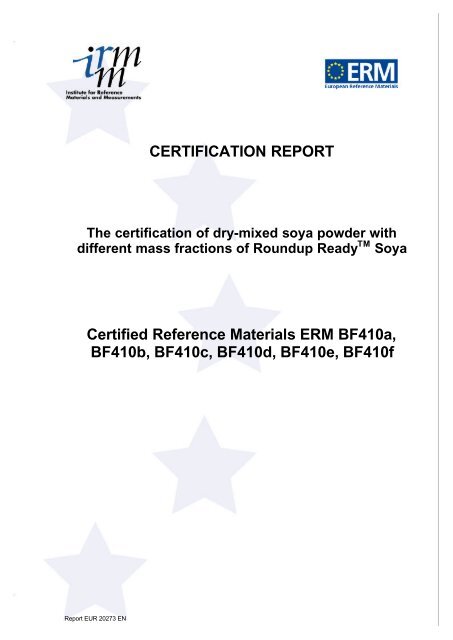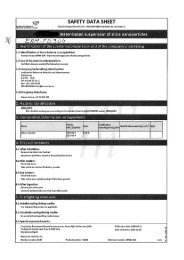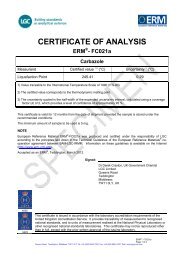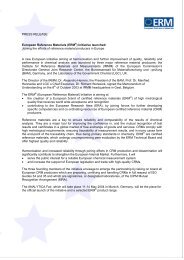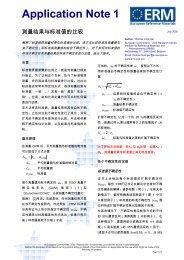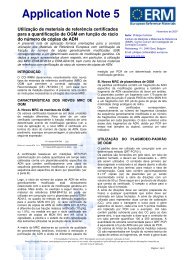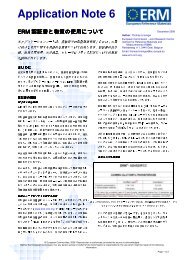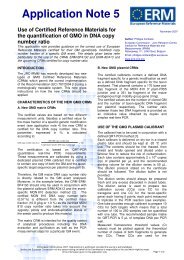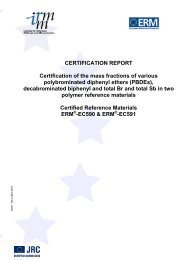IRMM information - European Reference Materials
IRMM information - European Reference Materials
IRMM information - European Reference Materials
Create successful ePaper yourself
Turn your PDF publications into a flip-book with our unique Google optimized e-Paper software.
Report EUR 20273 EN<br />
CERTIFICATION REPORT<br />
The certification of dry-mixed soya powder with<br />
different mass fractions of Roundup Ready TM Soya<br />
Certified <strong>Reference</strong> <strong>Materials</strong> ERM BF410a,<br />
BF410b, BF410c, BF410d, BF410e, BF410f
Report EUR 20273 EN<br />
<strong>IRMM</strong> Information<br />
<strong>Reference</strong> <strong>Materials</strong><br />
The Certification of <strong>Reference</strong> <strong>Materials</strong><br />
of Dry-mixed Soya Powder with different<br />
Mass Fractions of Roundup Ready TM Soya<br />
<strong>IRMM</strong>-410S
Mission<br />
The mission of <strong>IRMM</strong> is to promote a common <strong>European</strong> measurement system in<br />
support of EU policies, especially internal market, environment, health and consumer<br />
protection standards.
Report EUR 20273 EN<br />
<strong>European</strong> Commission<br />
<strong>IRMM</strong> <strong>information</strong><br />
REFERENCE MATERIALS<br />
The Certification of <strong>Reference</strong> <strong>Materials</strong><br />
of Dry-Mixed Soya Powder with different<br />
Mass Fractions of Roundup ReadyTM Soya<br />
<strong>IRMM</strong>-410S<br />
(<strong>IRMM</strong>-410S-0/<strong>IRMM</strong>-410S-1/<strong>IRMM</strong>-410S-2/<strong>IRMM</strong>-410S-3/<strong>IRMM</strong>-410S-4/<strong>IRMM</strong>-410S-5)<br />
S. Trapmann, P. Catalani, P. Conneely, P. Corbisier, D. Gancberg, E. Hannes,<br />
L. Le Guern, G. N. Kramer, J. Prokisch, P. Robouch, H. Schimmel, R. Zeleny and<br />
J. Pauwels<br />
<strong>European</strong> Commission, Joint Research Centre<br />
Institute for <strong>Reference</strong> <strong>Materials</strong> and Measurements (<strong>IRMM</strong>), Geel (BE)<br />
G. Van den Eede, F. Weighardt, M. Mazzara and E. Anklam<br />
<strong>European</strong> Commission, Joint Research Centre<br />
Institute for Health and Consumer Protection (IHCP), Ispra (IT)
Legal Notice<br />
Neither the <strong>European</strong> Commission nor any person acting on behalf of the Commission is responsible<br />
for the use which might be made of the following <strong>information</strong>.<br />
Reproduction is authorized provided the source is acknowledged<br />
http://www.jrc.cec.eu.int/<br />
© <strong>European</strong> Communities, 2002<br />
Printed in 2002
SUMMARY<br />
This report describes the preparation and certification of dry-mixed soya powder CRMs (<strong>IRMM</strong>-<br />
410S-0) with different mass fractions of genetically modified Roundup Ready TM soya powder<br />
(Certified reference materials <strong>IRMM</strong>-410S-0, <strong>IRMM</strong>-410S-1, <strong>IRMM</strong>-410S-2, <strong>IRMM</strong>-410S-3,<br />
<strong>IRMM</strong>-410S-4 and <strong>IRMM</strong>-410S-5). The CRMs were produced in 2001 by the Joint Research<br />
Centres of the <strong>European</strong> Commission, the Institute for <strong>Reference</strong> <strong>Materials</strong> and Measurements<br />
(<strong>IRMM</strong>) in Geel, Belgium. The CRMs are intended for the validation and calibration of methods for<br />
the detection of genetically modified food. The Roundup Ready TM concentration of <strong>IRMM</strong>-410S<br />
was verified with the help of DNA based and protein based detection methods. The CRMs are<br />
available in the form of glass bottles containing 1 g of soya powder packed under argon atmosphere.<br />
Seeds of non-modified soya (line A1900) and Roundup Ready TM (event 40-3-2, line AG5602 RR)<br />
both produced by Asgrow (Faribault, MO, USA) and delivered by Monsanto (St.Louis, MO,<br />
USA) were rinsed with demineralised water, additionally drained and dried at 30°C in order to<br />
minimise dust contamination from other crops. The materials were prepared by quantitative Turbula<br />
and dry-mixing of non-modified soya powder and 100% Roundup Ready TM GMO soya powder. It<br />
is recommended to use samplings not smaller than 100 mg. Bottles should be stored dry and cool<br />
(+4 °C) and kept in the dark.
TABLE OF CONTENT<br />
1. Introduction 1<br />
2. CRM Preparation 1<br />
2.1 Characterisation of the starting materials 1<br />
2.2 Production of powdery base materials 5<br />
2.3 Homogeneity study for dry-mixed maize powder 5<br />
2.4 Quantitative preparation of GMO/non-GMO mixtures 6<br />
2.5 Additional sieving and grinding steps 7<br />
2.6 Bottling 8<br />
2.7 Production control 8<br />
2.8 Minimum sample intake for analysis 10<br />
3. Certified mass fractions of GMO 10<br />
4. Verification of Roundup Ready TM mixtures 11<br />
4.1 Verification with DNA based methods 11<br />
4.2 Verification with protein based methods 15<br />
4.3 Comparison of results obtained with both methods 16<br />
4.4 Results 17<br />
5. <strong>Reference</strong>s and acknowledgements 17<br />
5.1 <strong>Reference</strong>s 17<br />
5.2 Acknowledgements 17<br />
6. Annex 19
1 Introduction<br />
Genetic modification of agricultural products is becoming an increasingly important item and<br />
authorisations to market such products are more and more under discussion. However, in the EU<br />
such authorisations are being combined with the obligation to declare food containing ingredients<br />
from genetically modified plants [1]. This enforces the necessity to develop suitable detection<br />
methods, and subsequently the use of certified reference materials. Therefore, the preparation of<br />
CRMs of mixtures of genetically modified (GMO) and non-genetically modified organisms has been<br />
started to allow proper validation of screening methods for the detection of genetic modification in<br />
agricultural and food products.<br />
A set of CRMs of soya powder with different mass fractions (0, 0.1, 0.5, 1, 2, 5 %) of dried<br />
powder of genetically modified soya (Roundup Ready TM ) was produced by <strong>IRMM</strong>. The six CRMs<br />
(<strong>IRMM</strong>-410S-0, <strong>IRMM</strong>-410S-1, <strong>IRMM</strong>-410S-2, <strong>IRMM</strong>-410S-3, <strong>IRMM</strong>-410S-4 and <strong>IRMM</strong>-<br />
410S-5) are available from <strong>IRMM</strong> and its authorised distributors [2].<br />
<strong>IRMM</strong>-410S is replacing <strong>IRMM</strong>-410R, which was sold out in 2001. In contrary to <strong>IRMM</strong>-410R,<br />
<strong>IRMM</strong>-410S has been produced with the help of dry-mixing techniques in order to minimise DNA<br />
and protein degradation occurring during the production.<br />
2 CRM Preparation<br />
2.1 Characterisation of the starting materials<br />
For the preparation of the CRMs, 80 kg non-modified soya (Agrow line A1900) delivered by<br />
Monsanto (St.Louis, MO, USA) and 20 kg GMO Roundup Ready TM (event 40-3-2, Asgrow line<br />
AG5602 RR, [3]) delivered by Monsanto (St.Louis, MO, USA) of seed quality were supplied to<br />
<strong>IRMM</strong>.<br />
The delivered non-GMO seed batches have been tested at Monsanto (St. Louis, MO, USA) for<br />
their purity using ELISA and PCR techniques. Sixty pools of 50 seeds, each, of the conventional<br />
non-GMO soybean, line A1900, were qualitatively tested by immunoassay for CP4 EPSPS<br />
protein. All 60 pools of seed tested negative for CP4 EPSPS, which gave a 95% confidence that<br />
this batch of soybean seed is greater than or equal to 99.9% free of seed expressing the CP4<br />
EPSPS protein.<br />
Roundup Ready TM (RR) soybean 40-3-2 event-specific and 61-67-1 construct-specific multiplex<br />
PCR with aat (asparatate aminotransferase) internal control was used to confirm the identity and<br />
purity of soybean line A1900. For the A1900 seed, three pools of 50 seeds tested negative by<br />
PCR for both 40-3-2 and 61-67-1 and positive for the aat internal control. This confirmed the<br />
immunoassay results.<br />
Additionally the purity of the non-GMO base material has been tested after washing of the seeds<br />
and the first grinding (as described in chapter 2.2), in order also to test for remaining surface<br />
contaminations. GMO contaminations in the non-GMO material close to the detection limit (LOD)<br />
of the EPSPS real time-PCR (rt-PCR) method were measured (table 1). The LOD was calculated<br />
equal to (3.3*σ)/S, with σ representing the standard deviation of a defined GMO percentage and S<br />
the slope of the calibration curve. The defined GMO percentage was the lowest GMO percentage<br />
for which the amplification efficiency was optimal. The efficiency of the amplification was<br />
1
determined on basis on the slope of the regression line between the GMO percentage and the Ctvalues,<br />
which should not be lower than the theoretical value of 3,322. The LODs have been<br />
established on genomic plant DNA and are 0.019% for the EPSPS specific PCR, 0.124 % for 35S<br />
PCR and 0.09 % for the NOS PCR.<br />
Table 1: Quantitation of GMO contaminations in the non-GMO base material with 35S<br />
and EPSPS specific real-time PCR, determination in triplicate using 20 mg/extraction<br />
Non-GMO raw material<br />
35S PCR 1<br />
NOS PCR 1<br />
Number of<br />
measurements<br />
2<br />
Concentration of GMO<br />
contamination 2<br />
[n] [%] stdev<br />
5 0.006 0.003<br />
5 0.007 0.005<br />
EPSPS specific PCR 5 0.015 0.012<br />
1 Percentage is given as an indicative value since it is lower than the LOD for the 35S.<br />
2 Primers used can be found in the annex.<br />
For the determination of the purity and confirmation of the uniform zygosity of the GMO RR starting<br />
material 50 randomly chosen seeds were germinated on moistened paper in a growing chamber<br />
under identical conditions during 15 days. 50-mg pieces from young leaves were sampled from 46<br />
plants. The plant tissues were disrupted in a lysis buffer using the Mixer Mill MM 300 (Retsch,<br />
Haan, DE) and 3-mm tungsten carbide beads (Qiagen, Hilden, DE). Total DNA was extracted<br />
using the DNeasy® 96 Plant kit (Qiagen, Hilden, DE). The total DNA was analysed on a 0.7 %<br />
agarose gel and quantified using the PicoGreen® dsDNA quantitation kit (Molecular Probes<br />
Europe, Leiden, NL). The average DNA yield was 8.2 ± 1.26 µg/50 mg tissue. On basis of the<br />
agarose gel, DNA showing a high level degradation was not further taken into account for real time<br />
PCR analysis. The detection of RR soybeans was performed following the TaqMan® Universal<br />
PCR Master Mix protocol (Applied Biosystem, Foster City, CA, USA). A primer pair specific for<br />
the modified EPSPS gene (transgenic construct between the cauliflower mosaic virus 35S promotor<br />
and the Petunia hybrida 5-enolpyruvylshikimate-3-phosphate synthase signal peptide) was used<br />
together with a reporter-dye labelled with FAM. The threshold cycle values (CT) obtained after the<br />
PCR on the 46 plants (figure 1) were compared to a calibration curve obtained with 100% RR<br />
DNA diluted in 0% RR DNA.
Figure 1: Real-time PCR quantiation of the EPSPS gene from 25 young leaves in<br />
triplicate. The fluorescent signals below the threshold base line are those obtained with non-GMO<br />
control soybeans, without template or with an 0.2% SDS-inactivated polymerase.<br />
Figure 2: Real-time PCR quantitation of the lectin gene from 25 young leaves in triplicate.<br />
The calculated percentage of GMO was then corrected using primers targeting the soybean lectin<br />
gene as an additional estimation of total soybean DNA. The calculated average percentage of RR<br />
soybeans was 105.51% ± 11.40 (n=46) and no samples had a percentage value below 87.3 %. It<br />
could be concluded, that all plants were therefore homozygous (table 2).<br />
3
Table 2: Molecular composition and determination of uniform zygosity of the Roundup<br />
Ready TM starting material used for the production of <strong>IRMM</strong>-410S<br />
PCR method performed<br />
and primers used<br />
EPSPS specific real-time PCR<br />
(RRS-F primer and RRS-R primer) 1<br />
1 primer sequences can be found in the annex<br />
Number of<br />
plants tested<br />
4<br />
Number of<br />
heterozygous<br />
kernels<br />
Number of<br />
homozygous<br />
kernels<br />
46 0 46<br />
In order to determine the total DNA content of GMO and non-GMO starting material, the DNA<br />
was extracted using two different plant DNA extraction kits from Macherey-Nagel (Düren, DE)<br />
and from Qiagen (Hilden, DE) and using a CTAB method [4]. The DNA was afterwards quantified<br />
with the help of UV photometry at 260 nm (BioPhotometer from Eppendorf, Hamburg, DE) and<br />
with the Picogreen assay (Molecular Probe, Leiden, NL) in a spectrofluorometer (Fluostar Galaxy<br />
from BMG Labtechnologies GmbH, Offenburg, DE). After correction for the water content of the<br />
material, no significant differences in DNA extractability in the base material has been observed<br />
(table 3).<br />
Table 3: Ratio of DNA content of GMO and non-GMO powdery base material, corrected<br />
for the water content, determined after the first grinding procedure (as described in<br />
chapter 2.2)<br />
Extraction<br />
Method<br />
Detection<br />
method<br />
Macherey- UV260nm<br />
Nagel Plant kit Photometry<br />
Macherey- Fluorimetry<br />
Nagel Plant kit (Picogreen)<br />
CTAB [4] UV260nm<br />
Photometry<br />
CTAB [4] Fluorimetry<br />
(Picogreen)<br />
DNeasy Plant UV260nm<br />
Mini Kit Photometry<br />
DNeasy Plant Fluorimetry<br />
Mini Kit (Picogreen)<br />
n DNA content of Roundup Ready TM soya powder<br />
DNA content of non-GMO soya powder<br />
6 1.18 ± 0.09<br />
6 1.09 ± 0.11<br />
6 1.08 ± 0.57<br />
6 1.27 ± 0.32<br />
6 0.87 ± 0.37<br />
6 1.00 ± 0.29
2.2 Production of powdery base materials<br />
Prior to the production of <strong>IRMM</strong>-410 the kernels of the non-GMO batch and GMO batch were<br />
separately thoroughly mixed.<br />
During the production of the GMO and non-GMO powdery base materials each material was<br />
treated separately. Cross contamination and contamination with foreign DNA were avoided with<br />
the help of glove box systems, clean cells, disposable lab clothing and treatment of all contact<br />
surfaces prior to exposure to the base materials with a DNA destroying solution.<br />
The kernels used for production were rinsed in demineralised water and after draining dried under<br />
vacuum at 30°C for 25 hours. The dried starting materials were then ground using a fine impact mill<br />
(track mill). The ground materials were collected in plastic bags and placed in polyethylene<br />
containers. Particle size analysis and water analysis proved that both base materials had a similar<br />
particle size distributions and water contents.<br />
2.3 Homogeneity study for dry-mixed soya powder<br />
Prior to the production a homogeneity study for dry-mixed soybean powders has carried out,<br />
mixing Au spiked soybean powder with non-spiked, non-GMO soybean powder. All powders<br />
used in the homogeneity study have been processed in the same way as described for the base<br />
materials in chapter 2.2. A 10 % dilution was produced first and afterwards diluted two times<br />
further to reach concentration of 1 and 0.1 % Au spiked in non-spiked soya. During the analysis the<br />
Au concentration of the three mixtures was determined with the help of neutron activation analysis<br />
(NAA). NAA proved the homogeneity of the dry-mixed soya powder (table 4) and the adequacy<br />
of the dry-mixing technology for the preparation of the non-GMO/GMO soybean mixtures.<br />
Table 4: Homogeneity study on dry-mixed Au-spiked soya powder with non-spiked<br />
soybean powder, results of Au determination by neutron activation analysis (NAA) with a<br />
sample intake of 50 mg<br />
Material Mixture parts (%) Results NAA<br />
Au-spiked Non-spiked Au content RSD<br />
(ppm)<br />
(%)<br />
Au-spiked soya 100 0 1182 0.8<br />
Non-spiked soya 0 100 0.007 26.8<br />
10 % mixture 10 80 120 2.8<br />
1 % mixture 1 98 12.1 5.2<br />
0.1 % mixture 0.1 99.8 1.50 6.1<br />
During the dry-mixing study it has been observed, that ground soybean powder contains a fraction<br />
of particles > 500 µm independently of the grinding techniques applied (table 5). The fraction > 500<br />
µm proved to consist mostly of seed covers. The flexibility of the skinny material allowed the<br />
particles to fold and even pass inserted sieves.<br />
Soybean powder ground more than once with a track mill formed a sticky powder which either<br />
blocks the mill or in the case of cryo-grinding was not suitable for the dry-mixing. It has therefore<br />
5
een decided to reduce the larger particles in an additional sieving and grinding step (see chapter<br />
2.5). In order to have a whole meal soybean reference material, no fractions have been removed<br />
during the production.<br />
Table 5: Particle sizes of soybean powder after application of various grinding techniques<br />
determined by sieving test<br />
Particle<br />
size<br />
Soybean powder<br />
after 1 st fine impact<br />
mill grinding<br />
(without sieve insert)<br />
Soybean powder<br />
after 2 nd fine impact<br />
mill grinding<br />
(without sieve insert)<br />
6<br />
Soybean powder<br />
after cryo-grinding<br />
(with 500 µm sieve<br />
insert)<br />
[µm] [weight %]<br />
< 63 21 3 1<br />
63-90 40 42 14<br />
90-125 12 17 44<br />
125-180 9 30 4<br />
180-250 7 2 0<br />
250-355 6 3 0<br />
355-500 3 1 0<br />
> 500 2 2 1<br />
2.4 Quantitative preparation of GMO/non-GMO mixtures<br />
Mixtures containing 0.1, 0.5, 1, 2, and 5 % Roundup Ready TM soybean powder in non-genetically<br />
modified soya powder and the 0 % RR soybean powder were prepared quantitatively using a drymixing<br />
method. Water contents of the ground GMO and non-GMO powders, used as base<br />
materials, were determined in threefold by Karl Fischer titration in order to correct for the water<br />
content of the material (table 6). A 10 % GMO mix was produced first using 100 % GMO and<br />
non-GMO base material. All lower concentrations were achieved by further dilution with non-<br />
GMO maize powder. The dilution factor was kept below 10 as this factor has been tested in the<br />
homogeneity study. Powders were weighed using calibrated balances. Weighing details are given as<br />
well in table 6.
Table 6: Water content and weighing details of powdery base materials used for the<br />
production of <strong>IRMM</strong>-410S<br />
<strong>IRMM</strong><br />
Water content<br />
-410S<br />
of base material Mass after water correction<br />
GMO GMO base material non-GMO base GMO non- Total<br />
content used<br />
material used base GMO weight of<br />
material base mixture<br />
used material<br />
used<br />
(%) GMO GMO GMO non- non- non- (g) (g) (g)<br />
(%) water<br />
content<br />
(%)<br />
water<br />
content<br />
n =3<br />
(stdev)<br />
GMO<br />
(%)<br />
GMO<br />
water<br />
content<br />
(%)<br />
GMO<br />
water<br />
content<br />
n =3<br />
(stdev)<br />
10 100 6.70 0.26 0 5.70* 0.26 403.85 3596.15 4000.00<br />
5 10 5.27 0.25 0 5.70* 0.26 1995.45 2004.55 4000.00<br />
2 10 5.27 0.25 0 5.70* 0.26 797.09 3202.91 4000.00<br />
1 10 5.27 0.25 0 5.37* 0.21 399.62 3600.38 4000.00<br />
0.5 5 5.13 0.15 0 5.37* 0.21 399.62 3600.91 4000.00<br />
0.1 1 4.97 0.21 0 5.70* 0.21 397.23 3602.77 4000.00<br />
* Two containers with non-GMO base material with slightly different water content have been used.<br />
The calculated weight fractions were in a first step manually pre-mixed in container and afterwards<br />
turbula mixed. The whole material was then transferred into a dry-mixing device and mixed for 2<br />
min.<br />
The standard uncertainty on the dried GMO powder mass fractions of the CRM preparations (0.1,<br />
0.5, 1, 2 and 5 % GMO) is estimated at 0.1 % relative.<br />
2.5 Additional sieving and grinding steps<br />
In order to reduce the fraction of particles > 500 µm, the material once ground in a fine impact mill<br />
has been sieved for around 1.5 h (mesh size 500 µm) and the fraction > 500 µm ground for a<br />
second time using a laboratory grinder. After grinding the material was sieved again and the<br />
remaining fraction ground repetitively (in total up to 6 times) until a fraction too small for the<br />
laboratory grinder remained (table 7). As the grinding of such small volumes leads to an enormous<br />
temperature increase, which might damage the material, the grinding chamber has been cooled with<br />
circulating cooling liquid down to 5°C.<br />
7
Table 7: Additional sieving and grinding steps<br />
Material GMO<br />
content<br />
Amount of<br />
material sieved<br />
(500 µm mesh size)<br />
8<br />
Material<br />
exposed to<br />
additional<br />
grinding steps<br />
Material<br />
remaining<br />
<strong>IRMM</strong>-410S-0 0 % 4000 g 188 g 5 g<br />
<strong>IRMM</strong>-410S-1 0.1 % 4000 g 181 g 4 g<br />
<strong>IRMM</strong>-410S-2 0.5 % 4000 g 185 g 6 g<br />
<strong>IRMM</strong>-410S-3 1 % batch A 4000 g 190 g 7 g<br />
1 % batch B* 4000 g 200 g 5 g<br />
1 % batch C* 4000 g 194 g 8 g<br />
1 % batch D* 4000 g 140 g 5 g<br />
<strong>IRMM</strong>-410S-4 2 % 4000 g 187 g 7 g<br />
<strong>IRMM</strong>-410S-5 5 % 4000 g 194 g 7 g<br />
* Additional batches of 1 % material have been produced for future production of intentionally degraded<br />
material.<br />
The remaining fraction of 0.1-0.2 weight % mainly contained of skinny material originating from the<br />
seed cover of soya. The materials took up some water during the cooled grinding procedure and<br />
were therefore vacuum dried for around 8 h before any other application. As the goal was to<br />
produce a whole seed GMO CRM, the remaining fraction has been added to the rest of the batch<br />
and dry-mixed once more.<br />
2.6 Bottling<br />
The dry-mixed products were bottled in well-cleaned 10-mL brown glass vials using an automatic<br />
sampling device. The first 30 filled bottles of each batch were discarded as an additional measure<br />
against carry over contamination. Bottles were manually closed with rubber stoppers. Before final<br />
closure of the vials they were placed in the freeze-dryer, filled with argon and closed using the<br />
hydraulically moveable device of the freeze-dryer. All vials were sealed with aluminium caps to<br />
prevent opening of rubber stoppers during storage and transport.<br />
2.7 Production control<br />
The water content of the dry powders was determined by Karl Fischer titration and amounted<br />
typically to values in the range of 0.7 to 1.8 %. Additionally to the water content the water activity<br />
of the final product has been measured (table 8).<br />
In order to determine the particle size distribution a sieving test following ISO 3310-1 using sieves<br />
with meshes of 63, 90, 125, 180, 250, 355 and 500 µm has been carried out. 10 times 10 g of the<br />
1% powder has been used, proving that 99.8% of the final product < 500 µm with a typical<br />
average particle size between 63 and 180 µm (table 9 and 10).<br />
The fraction of particles > 500 µm from the 10 sieving tests have been collected and merged for a<br />
final sieving test using sieves with meshes of 710 and 1000 µm (table 10).
Table 8: Water content and water activity of <strong>IRMM</strong>-410S<br />
Water content<br />
Water activity<br />
CRM Certified<br />
[%]<br />
[g/100g] n Mean std dev n avr. std dev<br />
<strong>IRMM</strong>-410S-0 0.0 5 1.09 0.13 5 < 0.06 -<br />
<strong>IRMM</strong>-410S-1 0.10 5 1.13 0.10 5 < 0.06 -<br />
<strong>IRMM</strong>-410S-2 0.50 5 0.89 0.04 5 < 0.06 -<br />
<strong>IRMM</strong>-410S-3 1.0 5 0.95 0.09 5 < 0.06 -<br />
<strong>IRMM</strong>-410S-4 2.0 5 0.79 0.18 5 < 0.06 -<br />
<strong>IRMM</strong>-410S-5 5.0 5 1.04 0.17 5 < 0.06 -<br />
Table 9: Particle size distribution of <strong>IRMM</strong>-410S, determined by sieving test<br />
CRM Certified<br />
Particle size distribution<br />
[g/100g] n<br />
Fraction<br />
[µm]<br />
[weight %] std dev<br />
< 63 0 0.0<br />
> 63, < 90 28 10.2<br />
> 90, < 125 41 9.2<br />
<strong>IRMM</strong>-410S-1 0.10 10 > 125, < 180 12 2.0<br />
> 180, < 250 9 1.0<br />
> 250, < 355 7 1.2<br />
> 355, < 500 4 0.5<br />
> 500 0* 0.0<br />
* residual particles with a size > 500 µm are due to their total weight < 0.1g (m= 18.23 mg, s= 8.16 mg) not<br />
registered by the method (see table 10)<br />
Table 10: Particle size distribution of <strong>IRMM</strong>-410S, determined by sieving test, merged<br />
fractions of particles > 500 µm from 10 analysis (see table 9)<br />
CRM Certified<br />
Particle size distribution<br />
[g/100g] n<br />
Fraction<br />
[µm]<br />
[mg] [weight %]<br />
> 500 174.5 0.175<br />
<strong>IRMM</strong>-410S-1 0.10 1 > 500, < 710 2.6 0.003<br />
> 710, < 1000 0 0<br />
9
The contribution of the particle size to the uncertainty of the certified reference material has been<br />
estimated for the DNA based methods with the help of a programme and DNA extractability data<br />
obtained for the various particle size fractions [6]. It could be concluded, that the influence of the<br />
particle size distribution on the uncertainty of the material is < 5 % if an sample intake of 100 mg is<br />
used and no GMO concentration equal to or above 0.1 % are produced.<br />
Table 11: Uncertainty contribution calculated for a sample intake of 100 mg [6]<br />
Particle size<br />
[µm]<br />
C DNA<br />
[µg/g]<br />
GMO content<br />
[%]<br />
10<br />
Soya bean powder<br />
ground once in<br />
a track mill<br />
RSD [%]<br />
< 63 1170 0.1 % 4.62<br />
63-90 954 0.5 % 2.65<br />
90-125 806 1 % 1.66<br />
125-180 219 2 % 0.96<br />
180-250 163 5 % 0.74<br />
250-355 215 100% 0.20<br />
355-500 299<br />
500-1500 526<br />
2.8 Minimum sample intake for analysis<br />
The efficiency of the dry-mixing of soya powders was studied in a pilot trial carried out with Auspiked<br />
soya (chapter 2.3).<br />
For the recommended sample intake of 100 mg per analysis, one may estimate on the basis of the<br />
particle size distribution (average particle size < 125 µm) of the mixtures that this number is larger<br />
than 10 5 , which means that even for <strong>IRMM</strong>-410S-1 with 0.1% GMO content the number of GMO<br />
particles is larger than 100. On this basis uncertainties due to sample inhomogeneity were estimated<br />
(chapter 3).<br />
3 Certified mass fractions of GMO<br />
The materials <strong>IRMM</strong>-410S-0, <strong>IRMM</strong>-410S-1, <strong>IRMM</strong>-410S-2, <strong>IRMM</strong>-410S-3, <strong>IRMM</strong>-410S-4<br />
and <strong>IRMM</strong>-410S-5 form a set of 6 reference materials certified for the mass fraction of Roundup<br />
Ready TM soya powder. The certified mass fractions are based on quantitative dry-mixing of nonmodified<br />
soybean powder with RR soybean powder. Referring to the particle size distribution it is<br />
advised to use sample intakes not smaller than 100 mg. Taking into account the uncertainties of the<br />
weighing and of the humidity contents of the starting materials, uncertainties for the certified mass<br />
fractions at 100 mg level were estimated (table 12).
It must however be emphasised that due to the relatively large uncertainty inherent to quantitation of<br />
the total DNA content, the DNA/dry powder mass fraction of different lots soya kernels cannot be<br />
determined with the highest precision. Therefore, the ratio GMO-DNA/non-GMO-DNA in the<br />
reference materials may significantly deviate from the certified powder mass ratio values.<br />
Table 12: Uncertainty estimation (in g GMO dry powder per 100 g dry powder)<br />
CRM,<br />
certified<br />
content<br />
<strong>IRMM</strong>-<br />
410S-0<br />
<strong>IRMM</strong>-<br />
410S-1<br />
<strong>IRMM</strong>-<br />
410S-2<br />
<strong>IRMM</strong>-<br />
410S-3<br />
<strong>IRMM</strong>-<br />
410S-4<br />
<strong>IRMM</strong>-<br />
410S-5<br />
(u1) 1<br />
(u2) 2<br />
Standard<br />
Uncertainty<br />
(u3) 3<br />
Combined<br />
uncertainty<br />
Expanded<br />
uncertainty<br />
All six materials were analysed for consistency and not with the aim to quantify the gravimetrically<br />
prepared materials of verified purity.<br />
For the verification study a Roundup Ready<br />
11<br />
TM specific real-time PCR method based on the<br />
amplification of part of the EPSPS sequence [5] and an event specific method based on the<br />
amplification of the 35S-junction [7] has been used. Additionally a real-time PCR GMO screening<br />
method based on the detection of the CaMV 35S promoter [5] and Agrobacterium tumefaciens<br />
NOS terminator has been applied. The amplified PCR products are measured cycle-by-cycle with<br />
(u4) 4<br />
(u5) 5<br />
(uc) (U = 2 * uc)<br />
< 0.03 - - - 0.0115 - 0.0115 0.03<br />
0.10 0.0001 0.0003 0.009 0.0115 0.0033 0.0242 0.05<br />
0.50 0.0005 0.0015 0.020 0.0115 0.0165 0.05 0.10<br />
1.0 0.001 0.003 0.029 0.0115 0.033 0.0775 0.2<br />
2.0 0.002 0.006 0.041 0.0115 0.066 0.1265 0.3<br />
5.0 0.005 0.015 0.064 0.0115 0.165 0.2605 0.6<br />
1 mass determination uncertainty estimated at 0.1% (see chapter 2.4)<br />
2 humidity content stdev < 0.3 % (see table 7)<br />
3 inhomogeneity at 100 mg level with an average particle size of 125 µm<br />
4 purity of non-GMO base < 0.02 % (see chapter 2.1)<br />
5 purity of GMO base material 96.7 % (see chapter 2.1)<br />
4 Verification of Roundup Ready TM mixtures<br />
The verification study was carried out using DNA-based detection methods like polymerase chain<br />
reaction (PCR) and protein-based detection methods like enzyme-linked immunosorbent assay<br />
(ELISA).<br />
4.1 Verification with DNA based methods
target specific reporter and quencher dyes, which lead to an increased fluorescence. The number of<br />
cycles (Ct-value) which are required to pass a fluorescence threshold correlates with the amount of<br />
target DNA in the starting sample. Results obtained can be found in table 13-15. The detection and<br />
quantitation limits of the EPSPS method and the CaMV 35S and Agrobacterium tumefaciens<br />
NOS screening methods have been established by dilution of DNA extracted from the 100%<br />
powder in 0% DNA extracted from verified non-GMO plants (table 17). The calibration curves<br />
can be found in figure 3 and demonstrate the low specificity of the 35S screening method in soya<br />
material. The PCR products were also analysed by a 2% agarose gel electrophoresis (1xTBE) and<br />
stained with ethidium bromide to confirm the expected amplicon size.<br />
Table 13: Quantitation of Roundup Ready TM -DNA with an EPSPS specific real-time PCR<br />
[5], DNA extracted with DNeasy Plant Mini, determination in triplicate using 20<br />
mg/extraction.<br />
12
CRM<br />
Certified<br />
GMO<br />
concentration<br />
Number of<br />
measurements<br />
13<br />
TM 1<br />
Roundup Ready<br />
Concentration<br />
[%] [n] [%] std dev<br />
<strong>IRMM</strong>-410S-0 < 0.03 5 0.02 0.01<br />
<strong>IRMM</strong>-410S-1 0.10 ± 0.05 5 0.13 0.05<br />
<strong>IRMM</strong>-410S-2 0.50 ± 0.10 5 0.53 0.08<br />
<strong>IRMM</strong>-410S-3 1.00 ± 0.2 5 1.27 0.13<br />
<strong>IRMM</strong>-410S-4 2.0 ± 0.3 5 2.14 0.42<br />
<strong>IRMM</strong>-410S-5 5.0 ± 0.6 5 4.76 0.47<br />
1 primers used can be found in the annex<br />
Table 14: Quantitation of Roundup Ready TM -DNA with 35S junction real-time PCR [7],<br />
DNA extracted with DNeasy Plant Mini, determination in triplicate using 20<br />
mg/extraction.<br />
CRM<br />
Certified<br />
GMO<br />
Concentration<br />
Number of<br />
measurements<br />
TM 1<br />
Roundup Ready<br />
Concentration<br />
[%] [n] [%] std dev<br />
<strong>IRMM</strong>-410S-0 < 0.03 2 (0.006) 2<br />
(0.003)<br />
<strong>IRMM</strong>-410S-1 0.10 ± 0.05 2 0.05 0.01<br />
<strong>IRMM</strong>-410S-2 0.50 ± 0.10 2 0.35 0.06<br />
<strong>IRMM</strong>-410S-3 1.00 ± 0.2 2 1.17 0.11<br />
<strong>IRMM</strong>-410S-4 2.0 ± 0.3 2 2.16 0.25<br />
<strong>IRMM</strong>-410S-5 5.0 ± 0.6 2 5.19 1.17<br />
1 primers used can be found in the annex<br />
2 value below LOD (see table 17)
Table 15: Quantitation of Roundup Ready TM -DNA with 35S screening real-time PCR,<br />
DNA extracted with DNeasy Plant Mini, determination in triplicate using 20<br />
mg/extraction.<br />
CRM<br />
Certified<br />
GMO<br />
Concentration<br />
Number of<br />
measurements<br />
14<br />
Roundup Ready TM<br />
Concentration 1<br />
[%] [n] [%] std dev<br />
<strong>IRMM</strong>-410S-0 < 0.03 5 (0.02) 2<br />
(0.01)<br />
<strong>IRMM</strong>-410S-1 0.10 ± 0.05 5 0.05 0.01<br />
<strong>IRMM</strong>-410S-2 0.50 ± 0.10 5 0.24 0.07<br />
<strong>IRMM</strong>-410S-3 1.00 ± 0.2 5 0.75 0.20<br />
<strong>IRMM</strong>-410S-4 2.0 ± 0.3 5 1.73 0.15<br />
<strong>IRMM</strong>-410S-5 5.0 ± 0.6 5 4.93 0.24<br />
1 primers used can be found in the annex<br />
2 value below LOD (see table 17)<br />
Table 16: Quantitation of Roundup Ready TM -DNA with NOS screening real-time PCR,<br />
DNA extracted with DNeasy Plant Mini, determination in triplicate using 20<br />
mg/extraction.<br />
CRM<br />
Certified<br />
GMO<br />
Concentration<br />
Number of<br />
measurements<br />
Roundup Ready TM<br />
Concentration 1<br />
[%] [n] [%] std dev<br />
<strong>IRMM</strong>-410S-0 < 0.03 5 (0.007) 2<br />
(0.005)<br />
<strong>IRMM</strong>-410S-1 0.10 ± 0.05 5 0.09 0.024<br />
<strong>IRMM</strong>-410S-2 0.50 ± 0.10 5 0.56 0.33<br />
<strong>IRMM</strong>-410S-3 1.00 ± 0.2 5 1.03 0.34<br />
<strong>IRMM</strong>-410S-4 2.0 ± 0.3 5 2.03 0.43<br />
<strong>IRMM</strong>-410S-5 5.0 ± 0.6 5 4.89 0.58<br />
1 primers used can be found in the annex<br />
2 value below LOD (see table 17)
Table 17: Limit of detection (LOD) and limit of quantitation (LOQ) of the real-time PCR<br />
methods used for the verification, established by dilution of DNA extracted from 100 %<br />
powder in 0 % DNA extracted from verified non-GMO plants<br />
Real-time PCR method LOD [% GMO] LOQ [% GMO]<br />
EPSPS (table 13, [5]) 0.02 0.06<br />
35S junction (table 14, [7]) 1<br />
15<br />
0.02 -<br />
35S screening (table 15, [5]) 0.13 0.38<br />
NOS screening (table 16) 0.009 0.028<br />
Threshold value [Ct]<br />
1 theoretical LOD and LOQ on soya [8] based on 20 genome copies<br />
45<br />
40<br />
35<br />
30<br />
25<br />
20<br />
15<br />
10<br />
5<br />
0<br />
0.001 0.01 0.1 1 10<br />
Figure 3: Calibration curves for the EPSPS specific () and 35S screening () method<br />
established by dilution of DNA extracted from the 100% powder in 0% DNA extracted<br />
from verified non-GMO plants. The threshold values (cycle numbers) have been plotted<br />
against the log concentration of the GMO standard DNA in percent.<br />
4.2 Verification with protein based methods<br />
GMO concentration [%]<br />
Additionally all six materials were analysed with an ELISA test detecting the CP4 EPSPS protein<br />
(GMO ✓Soya Test Kit®, Strategic Diagnostics Inc., Newark, Delaware, USA). The system has<br />
been calibrated with non-GMO and 100% GMO material. The applied CP4 EPSPS protein
ELISA has a quantitative range between 0.3 and 2.5 %, the samples containing 5 % GMO were<br />
therefore diluted. Results obtained can be found in table 18.<br />
Table 18: EPSPS protein ELISA (GMO ✓Soya Test Kit®, Strategic Diagnostics Inc.,<br />
Newark, Delaware, USA) at a sample intake level of 0.5 g, data analysed with linear curve<br />
fit<br />
CRM<br />
Certified GMO<br />
concentration<br />
Number of<br />
measurements<br />
16<br />
Roundup Ready TM<br />
Concentration<br />
[%] [n] [%] std dev<br />
<strong>IRMM</strong>-410S-0 < 0.03 5 not detectable -<br />
<strong>IRMM</strong>-410S-1 0.10 ± 0.05 5 not detectable -<br />
<strong>IRMM</strong>-410S-2 0.50 ± 0.10 5 0.50 0.09<br />
<strong>IRMM</strong>-410S-3 1.00 ± 0.2 5 1.17 0.11<br />
<strong>IRMM</strong>-410S-4 2.0 ± 0.3 5 2.33 0.15<br />
<strong>IRMM</strong>-410S-5 5.0 ± 0.6 5 4.82 0.27<br />
4.3 Comparison of results obtained with both methods<br />
Results above the LOD obtained with the DNA based methods (table 13-16) and results obtained<br />
with the protein-based method (table 18) are compared in figure 4.<br />
GMO concentration determined by ELISA [%]<br />
6<br />
5<br />
4<br />
3<br />
2<br />
1<br />
0<br />
0<br />
0 1 2 3 4 5 6 7<br />
Certified GMO concentration [%]<br />
6<br />
5<br />
4<br />
3<br />
2<br />
1<br />
GMO concentration determined by PCR [%]
Figure 4: Quantitation of the Roundup Ready TM by ELISA () and by real-time PCR<br />
targeting the EPSPS (), the CaMV 35S-junction () the CaMV 35S () and the NOS<br />
() sequences.<br />
4.4 Results<br />
Quantitation of the GMO content of six mixtures of Roundup Ready TM soybean powder by DNA<br />
and protein based methods proved the consistency of CRM <strong>IRMM</strong>-410S (tables 13-16, 18 and<br />
figure 4). The results proved the consistency of the produced CRMs. The determination of the<br />
absolute GMO concentration has been detected correctly with the help of protein and DNA based<br />
methods when the systems have been calibrated with the 100% GMO material.<br />
One has to be careful to draw quantitative conclusions from measurements of unknown samples as<br />
DNA and/or protein based GMO quantitation may depend on varieties.<br />
5 <strong>Reference</strong>s and acknowledgements<br />
5.1 <strong>Reference</strong>s<br />
[1] EC No1139/98 on the labelling of certain foodstuffs produced from genetically modified<br />
organisms as amended by EC regulation 49/2000 and No 50/2000<br />
[2] Catalogue and sales conditions for certified reference materials:<br />
http://www.irmm.jrc.be/mrm.html<br />
[3] http://64.26.172.90/docroot/decdocs/gts40-3-2-update.pdf<br />
[4] Pietsch K., Waiblinger H.U., Brodmann P. and Wurz A. (1997): Screeningverfahren zur<br />
Identifizierung 'genteschnisch veränderter' pflanzlicher Lebensmittel, Deutsche Lebensmittel-<br />
Rundschau 2, 35-38.<br />
[5] Molekularbiologische Methoden (2001), in: Swiss Food Manual (Schweizerisches<br />
Lebensmittelbuch), Bundesamt für Gesundheit (eds.), Eidgenössische Drucksachen- und<br />
Materialzentrale, Bern<br />
[6] Prokisch J., Zeleny R., Trapmann S., Le Guern L., Schimmel H., Kramer G.N. and Pauwels J.<br />
(2001): Estimation of the Minimum Uncertainty for a GMO Containing maize sample candidate<br />
certified reference material, Fresenius J. Anal. Chem. 370 (7), 935-939.<br />
[7] Taveniers I.,Windels P., Van Bockstaele E. and De Loose M. (2001): Use of cloned DNA<br />
fragments for event-specific quantification of genetically modified organisms in pure and mixed food<br />
products, Eur. Food Res. Technol., 213: 417-424.<br />
[8] Kay S., Van den Eede G. (2001): The limits of GMO detection, Nature Biotechnology, 19(5),<br />
405.<br />
5.2 Acknowledgements<br />
Kim Magin and her staff from Monsanto (St.Louis, MO, USA) for the purity checks carried out on<br />
the non-GMO starting material.<br />
17
Seong Kon Lee from the National Agricultural Science & Technology Institute in Korea took care<br />
of the purity checks of the non-GMO shipment units during his stay at <strong>IRMM</strong>.<br />
Isabelle Taverniers from the Centre for Agricultural Research (CLO, Melle, BE) provided the<br />
Roundup Ready TM 35S-junction primers and probe.<br />
18
Annex I<br />
CaMV 35S real-time PCR (table 1, 13), [5]<br />
Primer:<br />
TM-35S-1: 5’-gcc tct gcc gac agt ggt-3’<br />
TM-35S-2: 5’-aag acg tgg ttg gaa cgt ctt c-3’<br />
Probe:<br />
35S-FAM: 5’-(FAM)-caa aga tgg acc ccc acc cac g-(TAMRA)-3’<br />
Amplicon size: 83 bp<br />
CaMV NOS real-time PCR (table 1, 16), [unpublished method]<br />
Primer:<br />
Nost5'F: 5’-ttg gca ata aag ttt ctt aag att gaa t-3’<br />
Nost5'R: 5'-aca tgc tta acg taa ttc aac aga aat t -3’<br />
Probe:<br />
NOS-FAM: 5’-(FAM)-ctg ttg ccg gtc ttg cga tga tta tca t-(TAMRA)-3’<br />
Amplicon size: 87 bp<br />
Soya specific lectin real-time PCR (table 14), [5]<br />
Primer:<br />
TM-Lectin-F: 5’-tcc acc ccc atc cac att t-3’<br />
TM-Lectin-R: 5’-ggc ata gaa ggt gaa gtt gaa gga-3’<br />
Probe:<br />
Lectin-FAM: 5’-(FAM)-aac cgg tag cgt tgc cag ctt cg-(TAMRA)-3’<br />
EPSPS specific real time PCR (table 1, 14), [5]<br />
Primer:<br />
RRS-F: 5’-gcc atg ttg tta att tgt gcc at-3’<br />
RRS-R: 5’-gaa gtt cat ttc att tgg aga gga c-3’<br />
Probe:<br />
RRS-FAM: 5’-(FAM)-ctt gaa aga tct gct aga gtc agc ttg tca gcg-(TAMRA)- 3’<br />
Amplicon size: 84 bp<br />
Junction Roundup Ready TM specific real time PCR (table 16), [7]<br />
Primer:<br />
35S4-JUNC: 5'-ctt tga aga cgt ggt tgg aa-3'<br />
RRS3-JUNC: 5'-aaa gga agg tgg ctc cta ca-3'<br />
Probe:<br />
TQ-JUN1: 5'-(TET)-aac gat ggc ctt tcc ttt atc gca at-(TAMRA)-3'<br />
Amplicon size: 148 bp<br />
19
<strong>European</strong> Commission<br />
EUR 20273 EN - Institute for <strong>Reference</strong> <strong>Materials</strong> and Measurements -<br />
The certification of <strong>Reference</strong> <strong>Materials</strong> of Dry-mixed Soya Powder with different Mass<br />
Fractions of Roundup Ready TM Soya - <strong>IRMM</strong>-410S<br />
Editors: S. Trapmann, P. Catalani, P. Conneely, P. Corbisier, D. Gancberg, E. Hannes,<br />
L. Le Guern, G. N. Kramer, J. Prokisch, P. Robouch, H. Schimmel, R. Zeleny and J. Pauwels,<br />
G. Van den Eede, F. Weighardt, M. Mazzara and E. Anklam<br />
Luxembourg: Office for Official Publications of the <strong>European</strong> Communities<br />
2002 - 21 pp. - 21.0 x 29.7 cm<br />
<strong>IRMM</strong> Information Series<br />
ISBN 92-894-3725-1<br />
Contact<br />
<strong>European</strong> Commission<br />
Joint Research Centre<br />
Institute for <strong>Reference</strong> <strong>Materials</strong> and Measurements<br />
Retieseweg<br />
B-2440 Geel<br />
Tel. +32 (0) 14 571 211<br />
Fax. +32 (0) 14 584 273<br />
http://www.irmm.jrc.be
The mission of the JRC is to provide customer-driven scientific and technical support for<br />
the conception, development, implementation and monitoring of EU policies. As a<br />
service of the <strong>European</strong> Commission, the JRC functions as a reference centre of<br />
science and technology for the Union. Close to the policy-making process, it serves the<br />
common interest of the Member States, while being independent of special interests,<br />
whether private or national.<br />
OFFICE FOR OFFICIAL PUBLICATIONS<br />
OF THE EUROPEAN COMMUNITIES<br />
L-2985 Luxembourg<br />
ISBN 92-894-3725-1<br />
ISBN 92-894-3725-1<br />
15 LA-NA-20-273-EN-C


